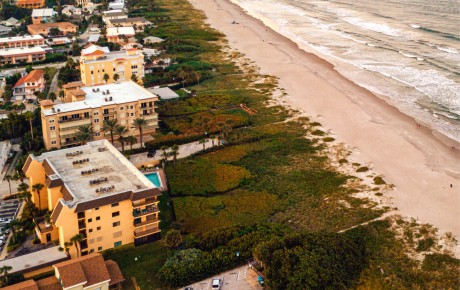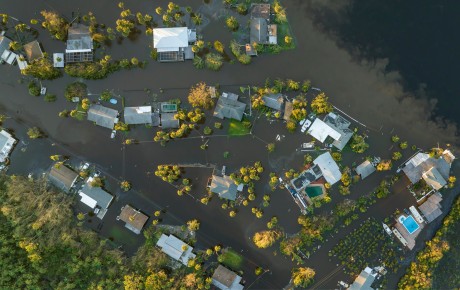
A tale of two storms
Hurricanes Florence and Michael might force a reappraisal of flood risk.
Two catastrophic hurricanes made landfall in the US in autumn 2018, but although Florence and Michael proved to be the biggest events of the year, they were very different storms. While slow moving Florence stalled over the Carolinas causing widespread flooding, Michael moved quickly over the Florida panhandle, creating a devastating storm surge. For homeowners, the devastation was the same with catastrophic flooding in both coastal and inland areas, further blurring the lines between regions in the US considered at high risk or low risk of flooding.
Slow Flo
The origins of the two storms could not have been more dissimilar. Hurricane Florence formed off the coast of Africa and tracked across the Atlantic strengthening into a Category 4 hurricane, providing ample warning of its arrival on the US east coast. By the time it made landfall in North Carolina it had weakened to a Category 1 storm, but while its potential for wind damage may have reduced, it dumped as much as 30 inches of rain as it slowly churned its way across the Carolinas, bringing flash flooding to coastal and inland areas.
Michael looks to have been the more devastating storm in insured terms, with estimates of up to $10 billion in insured losses compared to estimates for Florence ranging from $1.7 billion to $5 billion.
“Florence was a slow moving storm but once it made landfall it virtually stopped to sit over the Carolinas, making it the wettest storm in those states’ history. It was a slow flooding event, in that a lot of the insurance losses we’ve seen from Florence are from where rivers rose and crested from continuous rainfall,” says Tom King, Flood Underwriter for Hiscox London Market.
Hurricane Michael was a very different weather beast. Forming in the southwest Caribbean, due to the warmer air and sea surface temperatures it moved much quicker than Florence, arriving on Mexico Beach, Florida on 10 October when it was still a Category 4 storm packing winds of up to 155 mph. “With only four days passing between being classed as a tropical storm and then intensifying and hitting Florida as a hurricane, there was less time for state and federal authorities to issue guidance and prepare,” says King. “Where Michael made landfall, the wall of water it created wiped out many properties with a storm surge of up to 14 feet in coastal areas.”
Insured impact
Michael looks to have been the more devastating storm in insured terms, with estimates of up to $10 billion in insured losses compared to estimates for Florence ranging from $1.7 billion to $5 billion. The latest loss figures for Michael issued by the Florida Office of Insurance Regulation reveal that claims worth nearly $3.5 billion have already been made, with over 85,000 claims for residential property alone. It’s the uninsured losses though that reveal a picture of homeowners’ vulnerability to flood. Figures provided by the state governor of North Carolina, estimated total economic losses in the region of $17 billion[1] from Florence, with at least half that figure uninsured and requiring federal, state and private aid.
We have seen a definite increase in flood insurance quotes especially in the Carolinas, where affected properties were near rivers and in isolated areas.
With such a high rate of uninsured losses, could Florence and Michael be the trigger for many homeowners not in areas identified by the National Flood Insurance Program (NFIP) as being at high risk of flooding to buy cover?
It’s a possibility, King says. “We have seen a definite increase in flood insurance quotes especially in the Carolinas, where affected properties were near rivers and in isolated areas, with many of these quotes subsequently being bound. The flood risk has clearly been brought to many people's attention. However, more education is needed, particularly for homeowners who might simply not be aware that their standard policy does not cover flood or who think their property is in no danger of being flooded.”
The perception of flood risk is now moving away from the traditional lines drawn by the NFIP that say you’re either in a high risk or low risk area. Michael and Florence have shown that it’s a less binary distinction.
Florence could make people living in inland areas realise they are at risk, King adds. “Many of the homes hit were not regarded as being in a high risk flood zone. The perception of flood risk is now moving away from the traditional lines drawn by the NFIP that say you’re either in a high risk or low risk area. Michael and Florence have shown that it’s a less binary distinction.”
Growing awareness an opportunity for flood insurers
This growing awareness of flood risk should, in turn help the private flood-insurance market build its presence in the US. “Since the relaxation of the regulations around flood insurance in the US, the private market is now picking up around 15% of the risks being insured. We’re seeing more entrants, all of which have very different appetites, while the continued short term reauthorisation of the NFIP is creating uncertainty and could drive more premium flow to the private market,” comments King.
But for insurers to take the opportunity however, they have to offer a policy that will meet the needs of homeowners who might baulk at paying an additional $700 in premium on top of their homeowner’s policy. “We’re building our own view of risk based on multiple surge and inland flooding models to paint a highly detailed picture of the flood risk in the US that means we can offer more actuarily sound pricing. Ultimately, we want to offer a flood policy that a homeowner will look at alongside their traditional policy and see that they can round off their insurance coverage at a cost effective price,” says King.
Since the relaxation of the regulations around flood insurance in the US, the private market is now picking up around 15% of the risks being insured.
Make flood purchase an easy choice
Hurricanes Florence and Michael may have been different storms, but regardless of whether the result was storm surge or rain-induced flooding, they have both shown that flooding from hurricanes is as much of a risk as wind damage. “Just because you’re not on the beach doesn’t mean you’re not exposed to a flood. Homeowners inland, in areas previously categorised as low risk flood zones, are beginning to recognise the risk. It’s up to us as an industry to provide the products that will make the purchase decision an easy choice,” concludes King.
[1] https://files.nc.gov/ncosbm/documents/files/Florence_Report_Full_rev20181016v10.pdf




